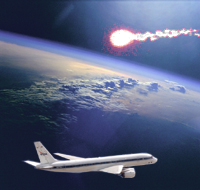|
AGENDA
WORKSHOP
"REENTRY EMISSION SIGNATURES"
Location: Hat Creek Room, SETI Institute, 515 N. Whisman Rd., Mountain View, CA 94043 (video conferencing available). Direction: Highway 101, exit Ellis street (south), turn right onto Fairchild Drive (immediately below offramp at sign "lodging") and go north parallel to highway in direction of San Francisco, then 2nd street left green sign "Whisman". The SETI Institute is just before the next traffic light on your left hand side (sign "SETI Institute"). Registration is in the lobby with the receptionist.
Contact local organizing committee: Peter Jenniskens (SETI Institute - Tel.: 1-650-961-6633)
Media contact: John Bluck (NASA Ames) and Karen Randall (SETI Institute - 1-650-9604537 / 1-650-961-6633)
Will be updated as abstracts are received.
Friday December 09: 13:00 - 17:00
Please anticipate presence of media
- 13:00-13:05 Frank Drake, SETI Institute - Welcome
- 13:05-13:15 Dean Kontinos, NESC - Introduction
- 13:15-13:30 Peter Jenniskens, SETI Institute - Results from the Genesis SRC Entry observing campaign
Session on predicted emission signatures
- 13:30-14:00 Mike Wright, NASA Ames - Predicted heating and emission signatures
- 14:00-14:20 Shinsuke Abe, Univ. Kobe - Prediction of the Near-UV spectrum of the reentry capsule
- 14:20-14:40 Michael Winter, Univ. Stuttgart - High resolution spectroscopic observations of the Stardust SRC entry
- 14:40-14:45 Discussion
- 14:45-15:00 tea break
Session on expected post-landing heat shield effects
- 15:00-15:30 Scott Sandford, NASA Ames - Recovery of heat shield outgassing and ablation pollution signatures
- 15:30-16:00 Frans Rietmeijer, Univ. New Mexico - Stardust's carbon heat shield ablation: carbon vapor condensates
- 16:00-16:30 Maegan Spencer, Stanford University - Chemical signatures from laser-desorption mass spectroscopy
- 16:30-16:40 Discussion
Session on remote sensing of the emission signatures
- 16:40-17:10 Ed Schilling, NASA Ames - Telescopic imaging of the Stardust SRC entry
- 18:00-20:00 Dinner at downtown restaurant
Saturday December 10: 09:00 - 17:00
|









